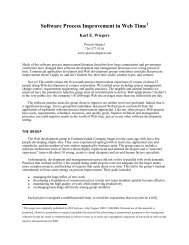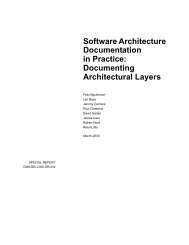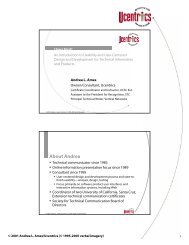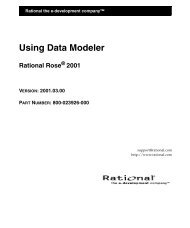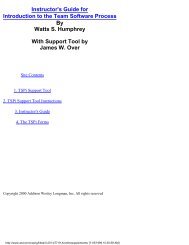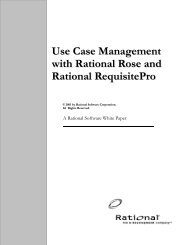RSI - A Structured Approach Use Cases and HCI Design
RSI - A Structured Approach Use Cases and HCI Design
RSI - A Structured Approach Use Cases and HCI Design
You also want an ePaper? Increase the reach of your titles
YUMPU automatically turns print PDFs into web optimized ePapers that Google loves.
The <strong>RSI</strong> <strong>Approach</strong> To <strong>HCI</strong> <strong>Design</strong> / <strong>Use</strong> Case Analysis Page 7 of 42<br />
1a. Submitted data is incomplete<br />
1a1 Insurance company requests missing information<br />
1a2 Claimant supplies missing information<br />
… etc.<br />
Note that some steps of this description (e.g. step 1) are unlikely to be automated. Cockburn<br />
goes on to describe how each step within the description can be viewed as a mini 'use case' in<br />
its own right - with its own goals. Thus use cases are decomposed into sub-use cases.<br />
Cockburn describes the classification of use cases into 'summary goals', 'user goals',<br />
'subfunctions' <strong>and</strong> 'dialog interactions' (at which level Cockburn describes goals such as 'move<br />
to next field using the tab key').<br />
Cockburn also clarified the difference between a scenario <strong>and</strong> a use case. Essentially, a<br />
scenario can be thought of as a particular occurrence (or instance) of a use case - so for<br />
example: "Elizabeth Cullinan claiming for the car accident on 3 September 1998 at Chiswick<br />
Roundabout in London" would be a scenario generalised in the above use case.<br />
The work presented here builds on Cockburn's approach. It differs in its classification of use<br />
case types; <strong>and</strong> in targeting the decomposition of use cases into interface <strong>and</strong> service subtypes.<br />
1.3. UML 1.3 «includes», «extends» <strong>and</strong> specialisation<br />
UML is a de-jure notational st<strong>and</strong>ard for object-oriented analysis <strong>and</strong> design notations<br />
(notations include use cases, class models, sequence diagrams, state models, etc.),<br />
administered by the Object Management Group (OMG). The current version (1.3) [15]<br />
defines three relationships between use cases:<br />
• one use case «includes» another<br />
«includes» is used to indicate that one use case is effectively a 'subroutine' of another (B<br />
is a subroutine of A, in this case). For example, Cockburn's use case 'get paid for car<br />
accident' might «include» a use case 'verify claim' for step 2.<br />
Get paid for car<br />
accident<br />
W5a - <strong>RSI</strong> LONG PAPER [42 PAGES].doc( Rev: 5) - 03/09/00<br />
<br />
Verify claim<br />
• one use case «extends» another<br />
«extends» is used to indicate one use case conditionally extending the behaviour of<br />
another. For example, a use case 'buy a car' might contain a sub-step 'pay for car with



